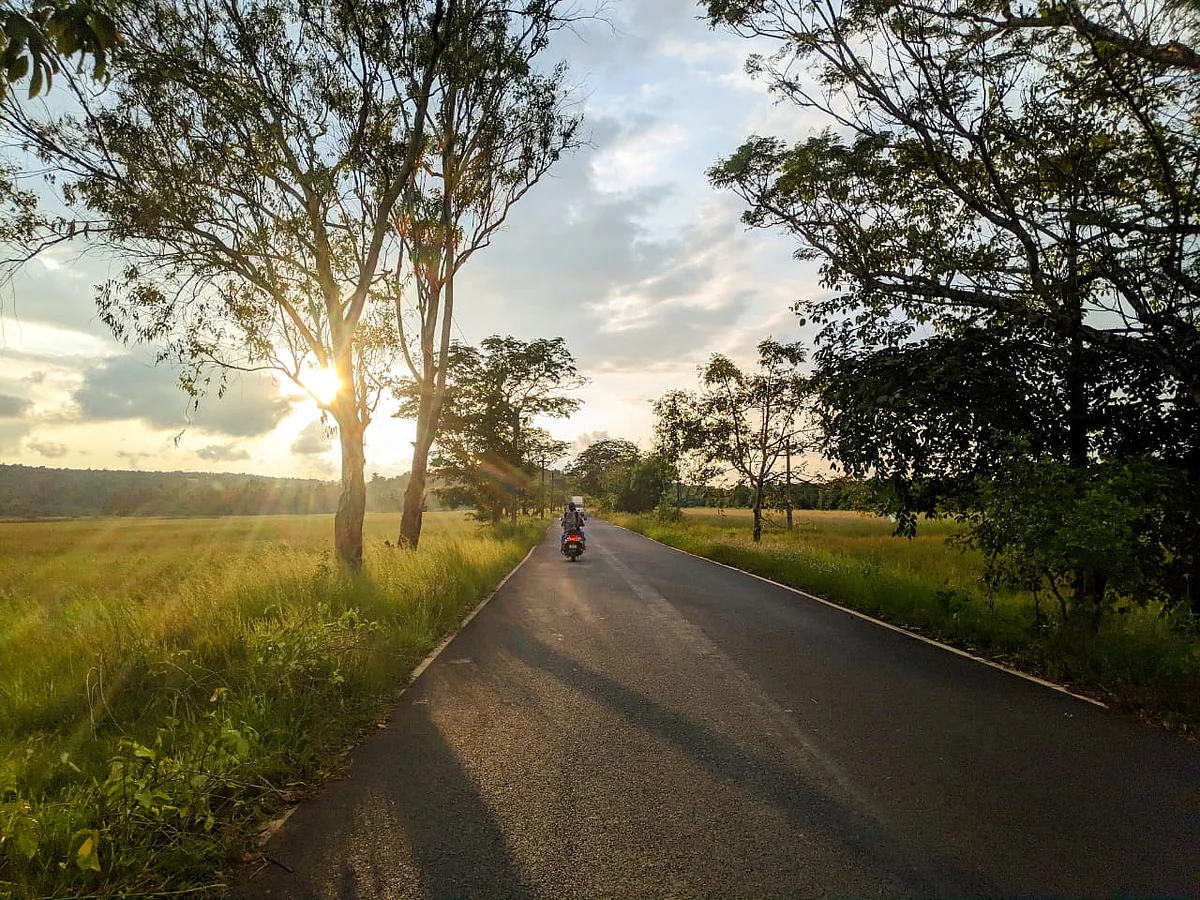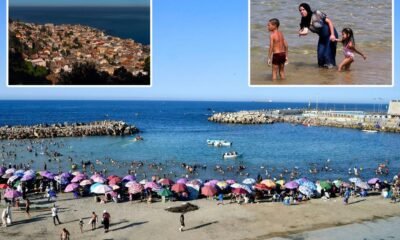Spiritual Travel
7 ways to seek spiritual awakening in Goa|Gomantak Times

WELLNESS WAYS
There is no dearth of wellness centres offering treatments and therapies to balance mind, body and spirit. These range from Ayurvedic massages, detoxification programs, and holistic healing practices for spiritual well-being.
Spiritual places in Goa|Goa spiritual discovery|Best places for peace in Goa|Spiritual sites Goa|Goa meditation spots
Spiritual Travel
What Role Do Sacred Destinations in Saudi Arabia, Israel, India, France, Italy, Japan, Spain, and Nepal Play in the Projected Two Hundred Sixty Billion Dollar Religious Tourism Growth?

Monday, July 28, 2025
The religious tourism industry is one of the most dynamic and rapidly growing segments in global travel, fueled by increasing interest in spirituality, pilgrimage experiences, and faith-based cultural exploration. As of 2024, the market is valued at $174.98 billion, and projections indicate a significant upward trajectory, reaching $190.53 billion in 2025, with a Compound Annual Growth Rate (CAGR) of 8.9%. By 2029, the religious tourism sector is set to reach $263.96 billion, demonstrating a CAGR of 8.5%. This growth is driven by a combination of factors, including the rising demand for personal spiritual journeys, technological innovations in booking and planning, increased accessibility to religious sites, and government-backed tourism initiatives across multiple regions.
Key destinations such as Mecca, Jerusalem, Varanasi, Lourdes, Vatican City, and Kyoto are at the forefront of this burgeoning sector. These sacred cities attract millions of travelers each year, drawn by the opportunity to deepen their spiritual connection, partake in religious ceremonies, and explore cultural landmarks. In addition, with the ongoing growth of low-cost airlines and improved transportation infrastructure, these religious destinations are becoming more accessible to international tourists, thus accelerating the expansion of religious tourism globally.
This report delves into the key drivers, market trends, regional insights, and future projections for the religious tourism sector, offering valuable insights into how the industry is shaping the global tourism landscape.
Key Market Drivers
1. Rising Interest in Spirituality and Well-being
A growing focus on holistic well-being has been a major driver of religious tourism. More people are seeking travel experiences that offer not only relaxation but also spiritual enrichment. This has led to a rising demand for pilgrimages, faith-based retreats, and spiritual tourism experiences that cater to an individual’s emotional and spiritual needs.
2. Advancements in Transportation Infrastructure
Improvements in transportation, such as the rise of budget airlines and the expansion of global travel networks, have made religious destinations more accessible. Pilgrimages to sites like Mecca, Lourdes, and Jerusalem, which were once costly and difficult to reach, are now more affordable and convenient, thanks to affordable airfare and improved infrastructure in many countries.
3. Government Initiatives and Investments
Governments worldwide are recognizing the economic and cultural benefits of religious tourism. Many countries are investing in the development of their religious tourism infrastructure. In India, for example, the government is investing in improving religious sites like the Varanasi temple and other pilgrim circuits to enhance the experience for visitors. Similarly, Saudi Arabia’s Vision 2030 plans to increase tourism by enhancing pilgrimage services for Muslims traveling to Mecca.
4. Technological Integration
The digital transformation in the travel sector has extended to religious tourism. With the rise of online booking platforms and virtual tours, travelers now have easy access to information about sacred sites and can book faith-based trips with ease. Technology is also making it possible to offer virtual pilgrimage experiences, expanding access to religious destinations for people who may not be able to travel in person.
Religious Tourism: Key Sites Around the World
Religious tourism has become a major driver of global travel, with millions of people visiting sacred sites every year to deepen their faith, partake in religious ceremonies, or experience cultural heritage. These pilgrimages and spiritual journeys span continents and religions, with each site offering a unique experience. From Mecca in Saudi Arabia to Varanasi in India, the following religious sites play pivotal roles in the global religious tourism market, driving significant economic revenue while fostering cross-cultural understanding.
1. Mecca, Saudi Arabia (Islamic Pilgrimage)
Mecca, located in Saudi Arabia, is the epicenter of Islamic spirituality. It is home to the Kaaba, the holiest site in Islam, situated within the Masjid al-Haram (Grand Mosque). Every year, Muslims from around the world travel to Mecca to perform the Hajj pilgrimage, a fundamental religious obligation for those who are physically and financially able. The Hajj attracts millions of pilgrims annually, making it one of the largest gatherings of people for religious purposes in the world.
Apart from Hajj, Mecca is also a year-round destination for Muslims visiting to perform Umrah, a lesser pilgrimage that can be undertaken at any time of the year. Saudi Arabia is investing heavily in its infrastructure to accommodate this influx of travelers, with developments such as the Makkah Metro, new hotels, and the expansion of the Grand Mosque. The government’s Vision 2030 plan aims to significantly increase the number of religious tourists visiting the Kingdom, promoting religious tourism as a major pillar of the country’s economy.
2. Jerusalem, Israel (Christian, Jewish, and Muslim Sites)
Jerusalem is one of the most significant cities in the world for religious tourism, revered by Christians, Jews, and Muslims alike. For Christians, the Church of the Holy Sepulchre, located in the heart of Jerusalem’s Old City, marks the site where Jesus Christ was crucified, buried, and resurrected. This makes it one of the most visited Christian pilgrimage sites. For Jews, the Western Wall (also known as the Wailing Wall) is the holiest site in Judaism, a remnant of the Second Temple that was destroyed in 70 CE. Muslims, on the other hand, regard the Al-Aqsa Mosque and the Dome of the Rock as sacred, with the latter marking the site where Prophet Muhammad ascended to heaven during the Isra and Mi’raj.
The convergence of these three major religions makes Jerusalem a focal point for religious tourism, with visitors coming from all over the globe to connect with their faith at these iconic locations. Despite political tensions, Jerusalem remains a significant pilgrimage destination and continues to drive tourism revenue for Israel.
3. Varanasi, India (Hindu Pilgrimage)
Varanasi, one of the world’s oldest continuously inhabited cities, holds immense spiritual significance for Hindus. Located on the banks of the Ganges River, it is believed that dying in Varanasi and being cremated there can lead to moksha, or liberation from the cycle of rebirth. The city is dotted with temples, ghats (riverfront steps), and shrines, making it a top pilgrimage destination in India. The Kashi Vishwanath Temple, dedicated to Lord Shiva, is one of the most visited religious sites in India.
Varanasi also attracts travelers who are interested in Hindu rituals and spiritual practices. Pilgrims come to take ritual baths in the Ganges, perform pujas (prayers), and witness traditional ceremonies like the Ganga Aarti, a spectacular evening ritual of devotion to the river goddess. Varanasi’s spiritual importance, combined with its rich cultural heritage, makes it a major hub for religious tourism, drawing millions of visitors annually.
4. Lourdes, France (Christian Pilgrimage)
Lourdes, located in the foothills of the Pyrenees Mountains in southwestern France, is one of the most visited Catholic pilgrimage sites in the world. The site became famous after a series of reported apparitions of the Virgin Mary to Bernadette Soubirous in 1858. Since then, Lourdes has attracted millions of pilgrims seeking healing, as it is believed that the spring water in the area has miraculous properties.
The Sanctuary of Our Lady of Lourdes, which includes the Basilica of the Immaculate Conception and the Grotto of Massabielle, remains the central attraction for visitors. Pilgrims from around the world visit Lourdes for religious ceremonies, spiritual healing, and to experience the sense of peace and devotion that permeates the site. Lourdes has become a beacon of hope for the sick, the suffering, and those seeking spiritual renewal, making it a vital part of the religious tourism industry in Europe.
5. Vatican City, Italy (Christian Pilgrimage)
Vatican City, an independent city-state within Rome, Italy, is the heart of the Roman Catholic Church. It is home to the Papal residence, the Pope, and some of the most iconic religious landmarks in the world. The St. Peter’s Basilica, with its awe-inspiring architecture, and the Sistine Chapel, known for Michelangelo’s famous ceiling fresco, are two of the most visited religious sites in Vatican City.
As the center of Catholicism, Vatican City attracts millions of visitors each year, who come to witness religious ceremonies, attend Mass, and receive the Pope’s blessing. The Papal audience and Easter Mass are especially popular events, drawing large numbers of religious tourists. The Vatican’s art and architecture also draw significant cultural tourism, making it a major destination for both faith-based and secular travelers.
6. Kyoto, Japan (Buddhist Pilgrimage)
Kyoto, once the capital of Japan, is home to an exceptional number of Buddhist temples and shrines, making it an important pilgrimage destination for Buddhists. Among the many significant sites in Kyoto are the Kinkaku-ji (Golden Pavilion) and the Fushimi Inari-taisha Shrine, which features thousands of iconic red torii gates leading up to the mountain.
Buddhist pilgrims and tourists alike visit Kyoto to experience the tranquility and serenity that Buddhist temples offer. Kyoto is also home to the Kiyomizu-dera, a temple that offers a panoramic view of the city and is associated with the belief that prayer there can lead to the fulfillment of wishes. Kyoto’s blend of natural beauty, historical significance, and Buddhist culture makes it a top destination for religious tourism in Japan.
7. Santiago de Compostela, Spain (Christian Pilgrimage)
Santiago de Compostela, located in the northwest of Spain, is the final destination of the famous Camino de Santiago pilgrimage. The journey, which spans across Europe and ends at the Cathedral of Santiago de Compostela, is one of the most significant Christian pilgrimages. It is believed that the remains of the apostle Saint James are buried within the cathedral, making it a major site for Christian pilgrims.
The Camino de Santiago has been a major route for religious travelers for centuries, and it continues to attract people from around the world. In addition to its religious significance, Santiago de Compostela also offers a rich cultural experience, with its medieval architecture, historic landmarks, and vibrant festivals, contributing to both religious and cultural tourism in Spain.
8. Bodh Gaya, India (Buddhist Pilgrimage)
Bodh Gaya, located in the state of Bihar, India, is one of the most sacred sites for Buddhists. It is here that Siddhartha Gautama, the historical Buddha, attained enlightenment under the Bodhi Tree. The Mahabodhi Temple, a UNESCO World Heritage site, marks the spot where Buddha achieved enlightenment and remains a key pilgrimage destination for Buddhists worldwide.
The temple complex, which includes the Bodhi Tree, the Ajapala Nigrodha Tree, and various stupas and monasteries, attracts thousands of pilgrims who come to meditate and reflect. Bodh Gaya is not only a spiritual center but also a place of historical and cultural importance, drawing religious tourists from across the globe.
Regional Insights
1. Middle East – The Heart of Islamic Pilgrimage
The Middle East remains the largest and most significant region in the religious tourism sector, particularly due to the importance of Mecca and Medina in Islam. Every year, millions of Muslims travel to Mecca to undertake the Hajj pilgrimage, making it one of the largest religious gatherings globally. Saudi Arabia is investing heavily in tourism infrastructure as part of its Vision 2030, which aims to diversify its economy and enhance the pilgrimage experience for both Hajj and Umrah travelers. The expansion of transportation networks and new developments like the Makkah Metro and luxurious hotels have significantly improved the overall pilgrimage experience.
2. Europe – Spiritual and Cultural Destinations
Europe is witnessing a resurgence in religious tourism, especially to Catholic sites such as the Vatican in Rome and Lourdes in France. These destinations, along with religious landmarks in Spain and Portugal, continue to attract millions of pilgrims and cultural tourists annually. Additionally, the integration of historical and cultural heritage with religious experiences is becoming a key factor driving growth in Europe’s religious tourism sector. Pilgrimages to Santiago de Compostela in Spain, for example, draw a steady flow of tourists year-round, blending spirituality with cultural exploration.
3. Asia-Pacific – Diversity of Religious Sites
Asia-Pacific offers a wide variety of religious destinations catering to Buddhists, Hindus, and other faiths. India’s Varanasi, one of the world’s oldest living cities, remains a major site for Hindu pilgrims. Buddhist pilgrims from across the globe travel to Bodh Gaya in India, Lumbini in Nepal, and Mount Fuji in Japan, attracted by the spiritual significance of these locations. As more people in the region embrace spirituality, the demand for faith-based travel is expected to increase, driving growth in the religious tourism market.
4. North America – Rising Demand for Faith-Based Retreats
While North America doesn’t have as many internationally renowned pilgrimage sites as other regions, it is still a growing market for religious tourism. Pilgrimages to the National Shrine of Our Lady of La Leche in Florida and the Shrine of Our Lady of Guadalupe in Mexico are gaining in popularity. Furthermore, the rise of wellness and spiritual retreats in the U.S. and Canada is contributing to the expansion of religious tourism, with travelers seeking transformative spiritual experiences that focus on self-discovery and inner peace.
Market Segmentation
1. By Type
- Domestic Religious Tourism: This category includes local pilgrimages, participation in regional religious festivals, and visits to spiritual retreats within the country.
- International Religious Tourism: This segment refers to travel across borders for religious purposes, such as attending global religious events or international pilgrimages.
2. By Religion
- Christianity: Major Christian pilgrimage sites include Jerusalem, Lourdes, and the Vatican.
- Islam: Mecca remains the most significant pilgrimage site for Muslims, while Medina also holds immense religious value.
- Hinduism: Varanasi, Puri, and the upcoming Ram Mandir in Ayodhya are significant destinations for Hindu pilgrims.
- Buddhism: Bodh Gaya in India and Lumbini in Nepal are major pilgrimage spots for Buddhists.
- Other Religions: Pilgrimages to sites important to Judaism, Sikhism, and other spiritual practices continue to be popular.
3. By Age Group
- Below 30 Years: Younger travelers are increasingly interested in spiritual tourism, combining faith with cultural and adventure travel.
- 30-40 Years: This age group often combines religious tourism with family vacations or personal reflection.
- 40-50 Years: Travelers in this category are more likely to seek meaningful spiritual journeys and retreats.
- Above 50 Years: Older adults are often drawn to pilgrimage destinations for reflection, inner peace, and spiritual growth.
4. By Sales Channel
- Online Sales: Online platforms are the preferred channel for booking religious tours, with many agencies offering customized itineraries.
- Offline Sales: Traditional travel agencies and local religious organizations still play a crucial role in guiding pilgrims and organizing tours.
Emerging Trends in Religious Tourism
1. Virtual Pilgrimages and Digital Transformation
Virtual pilgrimages are becoming increasingly popular, allowing individuals to experience sacred destinations remotely. Virtual reality (VR) and augmented reality (AR) technologies are enhancing the spiritual experience by allowing users to explore religious sites from the comfort of their own homes. This technology is expanding access to sacred locations that may have been previously inaccessible.
2. Eco-Friendly and Sustainable Practices
With growing environmental awareness, the religious tourism sector is increasingly adopting sustainable practices. From eco-friendly hotels to carbon-conscious transportation options, both pilgrims and tour operators are taking steps to reduce their environmental impact. Many religious destinations are also focusing on preserving sacred sites through green initiatives.
3. Personalized Spiritual Journeys
As more travelers seek meaningful spiritual experiences, religious tourism agencies are offering personalized services. These include customized itineraries that align with the spiritual needs of individuals, allowing for a more tailored and reflective journey.
Conclusion
Religious tourism is a rapidly growing sector that is set to reach new heights in the coming years, with projections estimating a market value of $263.96 billion by 2029. The demand for spiritual experiences, supported by advancements in technology, government initiatives, and improved transportation, is reshaping the landscape of global travel. Destinations like Mecca, Jerusalem, Varanasi, and Lourdes will continue to be key pillars of this growth. As the industry embraces emerging trends such as virtual pilgrimages, sustainable tourism, and personalized spiritual journeys, it is poised to offer even greater opportunities for travelers seeking both faith and personal enrichment.
This expanding market provides significant economic opportunities for countries and regions investing in their religious tourism infrastructure. By recognizing and responding to the evolving needs of spiritual travelers, the industry will continue to thrive and play an integral role in global tourism.
Spiritual Travel
Chhattisgarh CM Sai showers flowers on Kanwariyas from chopper; unveils Rs146cr Bhoramdeo spiritual tourism plan | Raipur News

RAIPUR: Chhattisgarh chief minister Vishnu Deo Sai on Monday organized a flower shower from a helicopter over thousands of Kanwariyas (Shiva devotees) marching in Kabirdham district as part of the third Monday of the holy Sawan month. Speaking to the media at the airstrip, CM Sai said that the govt is developing ‘Bhoramdeo corridor’ with a budget of Rs 146 crore which will have special facilities for pilgrims.
We are also in talks with the Madhya Pradesh govt to provide land in Amarkantak for setting up rest houses for Kanwariyas, CM said.Chief Minister along with deputy chief ministers Vijay Sharma, Arun Sao, and assembly speaker Dr. Raman Singh, took part in the spiritual celebration.Each year, Kanwariyas undertake a 100-km foot march from Amarkantak in MP to Bhoramdeo in Chhattisgarh, to offer sacred water at the historic temple. The govt organized a grand welcome, with local MLA Bhawna Bohra leading arrangements at Kabirdham.Across the region, saffron-clad men and women filled the streets, singing devotional songs and waving tricolour Kanwars.Chief Minister Sai said, “Rs 146 crore spiritual tourism project under the Swadesh Darshan 2.0 scheme will be developed as ‘Bhoramdeo Corridor’, aimed at transforming the iconic 11th-century temple into a holistic religious destination.”The announcement coincided with a grand floral shower by helicopter over Kanwar pilgrims at Bhoramdeo.Speaking to the media, CM Sai said the project would not only revamp the historic Bhoramdeo Temple complex but also integrate other spiritually significant sites, including Madwa Mahal, Cherki Mahal, Ramchua, and Saroda Reservoir, creating a seamless spiritual and heritage circuit.Located in Choura village, 18 km from Kawardha, the Bhoramdeo Temple is a sacred 11th-century archaeological marvel where Lord Shiva is worshipped as Baba Bhoramdeo.Thousands of pilgrims from Kabirdham, Mungeli, Bemetara, Khairagarh, Rajnandgaon, and even Amarkantak in Madhya Pradesh are participating this year as they undertake this journey barefoot, wearing saffron clothes, trekking up to 150 kilometers through rocky forest paths, reaffirming their faith with each step.To facilitate the 151-kilometer Kanwar Yatra, Deputy Chief Minister and Home Minister Vijay Sharma said that medical teams and police patrols have been deployed across key routes, including Kawardha-Bemetara Highway, Bhoramdeo Road, and forest stretches near Pandariya and Kukdoor.
Spiritual Travel
Haridwar’s tragedy: Safety is non-negotiable for India’s spiritual tourism economy
The stampede at Haridwar’s Mansa Devi Temple in late July, which claimed several lives and left scores injured, has once again exposed the chronic vulnerabilities of India’s pilgrimage tourism sector. The accident, triggered by panic during the height of the Shravan pilgrimage season, was a grim reminder that India’s religious economy one of the largest drivers of domestic tourism is built on a fragile foundation.
The pattern is disturbingly familiar. Major stampedes at temples and festivals have punctuated India’s recent history from the Vaishno Devi shrine in Jammu & Kashmir in 2022, to last year’s Hathras tragedy in Uttar Pradesh, which left 121 people dead. Most share common failings: overcrowded infrastructure, inadequate crowd control and a lack of emergency planning. Haridwar was no exception.
Since 2021, Haridwar has welcomed over 12.72 million tourists every year, according to official tourism data. That footfall translates into livelihoods for thousands. But the Mansa Devi tragedy now casts a shadow. As news spreads through viral videos, headlines, and anxious WhatsApp messages, there’s a real fear that prospective pilgrims will stay away, especially during peak periods like Shravan and Kumbh.
Pilgrimage tourism is big business. Haridwar alone attracts millions of visitors annually, underpinning a local economy of hotels, transport operators, food vendors and small traders. Nationally, religious tourism contributes billions of dollars to India’s GDP. But this economic engine relies heavily on public confidence. A single incident of this scale can deter pilgrims for months, and in some cases years, disrupting livelihoods that depend on steady visitor flows, dip in arrivals could translate into substantial revenue losses for hotels, transportation operators, small traders, and other ancillary businesses. The ramifications extend beyond short-term disruptions.
From crisis management to long-term safety planning
What makes this systemic neglect even more troubling is that solutions are neither complex nor out of reach. Technology-driven crowd management real-time monitoring, timed entry systems, and direct digital communication with pilgrims can dramatically reduce risk. Upgrading infrastructure to withstand peak footfalls, training security personnel, and enforcing stricter controls on gatherings are equally vital. Yet, investment in safety is too often treated as discretionary rather than as the non-negotiable foundation for sustaining tourism.
The consequences ripple far beyond the immediate tragedy. For local businesses, reduced pilgrim traffic can be financially crippling, especially for small enterprises that survive on narrow margins. For state governments, reputational damage translates directly into economic loss. And for India’s broader tourism economy, each incident erodes the country’s credibility as a safe and reliable destination.
Haridwar’s tragedy is not just a local failure; it is a national wake-up call
If India wishes to continue reaping the economic dividends of its vast religious tourism sector, safety must be treated as the bedrock, not the afterthought. Without systemic reforms spanning infrastructure, governance, and public accountability the next stampede may be only a festival season away.
The warning signs have been unmistakable. In 2025 alone, India has endured a string of devastating crowd disasters. The stampede at Haridwar’s Mansa Devi Temple was preceded by tragedy in Prayagraj, where, on January 29 during the Maha Kumbh Mela, at least 30 pilgrims were killed and over 60 injured. Just weeks later, on February 15, a deadly crush at New Delhi railway station claimed 18 lives as pilgrims made their way to the same festival. In Goa, at the Sri Lairai Devi Temple on May 3, a fire-walking ritual ended in panic, leaving six people dead.
Nor have these disasters been confined to religious gatherings. On June 4, a crowd surge during an IPL victory celebration at Bengaluru’s Chinnaswamy Stadium resulted in 11 fatalities. And then, Haridwar: a rumour of a loose electric wire on the temple stairway triggered panic that left multiple pilgrims dead and dozens injured within minutes.
These are not isolated events. They are systemic warnings. And they can no longer be ignored.
In places like Haridwar, the time for cosmetic fixes has long passed. Safety cannot be a last-minute checklist item; it must be woven into the very design and management of large gatherings. That means embracing digital ticketing and monitoring systems that pre-empt overcrowding. It requires wider walkways, clearly marked emergency exits, and round-the-clock medical facilities. Most importantly, it calls for empowering local authorities district officials, temple boards, and festival committees with the budgets, tools, and autonomy to act proactively rather than reactively.
Equally critical is visibility. When pilgrims and visitors see safety measures in action, it builds trust. And trust is what brings them back.
Cushioning the economic blow
Behind every news alert and statistic lies another quiet story, the kind that rarely makes headlines. A hotel with empty rooms. A food stall that used to sell out by noon is now barely making enough. A young boy who left school to help his parents recover their losses.
In pilgrimage towns, businesses often live season to season. A single tragedy can send shockwaves through these fragile economies. For many, there’s no safety net. The government must respond not just with statements of sympathy, but with real, tangible support. Emergency financial aid. Temporary GST relief. Easy-to-access loans for small traders and vendors trying to stay afloat.
But long-term recovery also means thinking differently. Haridwar has so much more to offer than just seasonal pilgrimages. With its natural beauty, deep-rooted traditions, and spiritual energy, it could become a centre for wellness, yoga, cultural exploration, and Ayurvedic healing. A more diversified tourism strategy could help smooth out seasonal spikes and create a more stable economic future.
A model for safer, sustainable pilgrimage
India is home to more than 300 major pilgrimage sites. In 2024, over 60 crore religious visits were recorded across the country. These numbers speak to the soul of a nation, but they also come with serious logistical responsibility.
Haridwar now has a chance to lead the way. To show the rest of India what it means to marry devotion with design, tradition with safety, and faith with planning. It can become more than a pilgrimage destination. It can become a national example of what safe, sustainable spiritual tourism looks like. That means investing in smart infrastructure. Creating safer spaces. Training emergency teams. Planning not just for celebration, but for the unexpected incidences. And making sure that every person, from a first-time visitor to a local resident, feels protected.
The stampede at Mansa Devi Temple is more than a moment of mourning it marks a critical inflection point. Haridwar now can recede into silence, or it can rise with purpose, transforming tragedy into a legacy of protection for generations to come.
In a country where faith is woven into daily life and pilgrimages sustain entire local economies, safety must not be an afterthought it must be part of the sacred pact between state, society, and the devotee. Every pilgrim sets out in hope, and that hope fuels hotels, transport operators, small traders, and a billion dollar religious tourism economy. When safety fails, it is not just lives that are lost; livelihoods crumble, businesses suffer, and destinations struggle to regain trust.
If India aspires to be a global leader in spiritual tourism, it must first lead in safety. Because no one seeking blessings should ever have to worry about returning home and no local economy should have to rebuild itself in the shadow of preventable tragedy.
Because in the end, safety is sacred too…
Disclaimer: The views expressed in this article are those of the author/authors and do not necessarily reflect the views of ET Edge Insights, its management, or its members
-

 Brand Stories1 week ago
Brand Stories1 week agoBloom Hotels: A Modern Vision of Hospitality Redefining Travel
-

 Brand Stories3 days ago
Brand Stories3 days agoCheQin.ai sets a new standard for hotel booking with its AI capabilities: empowering travellers to bargain, choose the best, and book with clarity.
-

 Destinations & Things To Do1 week ago
Destinations & Things To Do1 week agoUntouched Destinations: Stunning Hidden Gems You Must Visit
-

 AI in Travel1 week ago
AI in Travel1 week agoAI Travel Revolution: Must-Have Guide to the Best Experience
-

 Brand Stories3 weeks ago
Brand Stories3 weeks agoVoice AI Startup ElevenLabs Plans to Add Hubs Around the World
-

 Brand Stories2 weeks ago
Brand Stories2 weeks agoHow Elon Musk’s rogue Grok chatbot became a cautionary AI tale
-

 Destinations & Things To Do2 days ago
Destinations & Things To Do2 days agoThis Hidden Beach in India Glows at Night-But Only in One Secret Season
-

 Asia Travel Pulse3 weeks ago
Asia Travel Pulse3 weeks agoLooking For Adventure In Asia? Here Are 7 Epic Destinations You Need To Experience At Least Once – Zee News
-

 AI in Travel3 weeks ago
AI in Travel3 weeks ago‘Will AI take my job?’ A trip to a Beijing fortune-telling bar to see what lies ahead | China
-

 Brand Stories3 weeks ago
Brand Stories3 weeks agoChatGPT — the last of the great romantics












